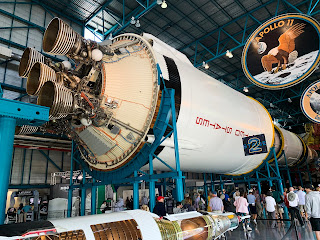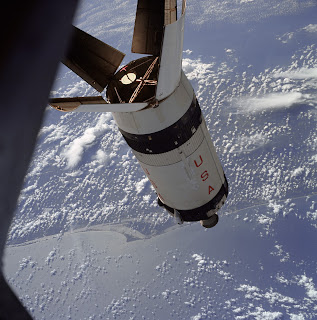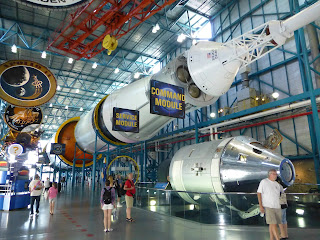SATURN-V for Dummies Part-2: The Machine Overview
 |
| Saturn-V with all its stages in Houston, USA |
The Boeing Company was awarded the contract to manufacture the S-IC first stage on December 15, 1961. By then, the general design of the first stage had been decided by the engineers at the MSFC. The MSFC engineers also built the first 3 test stages (S-IC-T, S-IC-S, S-IC-F), and the first two flight models (S-IC-1 and -2). The main place of manufacture was the Michoud Assembly Facility, New Orleans. Wind tunnel testing took place in Seattle and the machining of the tools needed to build the stages at Wichita, Kansas.
The largest and heaviest single component of the S-IC was the thrust
structure, with a mass of 22000kg. It
was designed to support the thrust of the five engines and redistribute it
evenly across the base of the rocket. There were four anchors which held down
the rocket as it built thrust. These were among the largest aluminum forgings
produced in the U.S. at the time, 4.3m long and 816kg in weight.
The four stabilizing fins withstood a temperature of 1100 °C.
 |
| S-IC stage on display at the Kennedy Space Centre |
The 2nd stage was about 25m tall, 10m in diameter, and provided 4,400kN of thrust to accelerate the Saturn-V through the upper atmosphere. The dry mass of the stage was 36200kg and, when fully fueled, it weighed 480000kg. Liquid hydrogen (LH2) was used as the fuel in this stage and liquid oxygen (Lox) was used as the oxidizer. The stage had five J-2 engines in a quincunx pattern. Similar to the S-IC; the center engine was fixed and the outer four were hydraulically gimballed.
North American Aviation was awarded the contract to manufacture S-II second stage on 11th September 1961 (Note: it is the same company that was awarded the contract for the Apollo Command / Service Module). They were also provided with the manufacturing plant at Seal Beach, California by the government.
Interestingly, this stage when fully loaded; had only 7.6% hardware, and the rest 92.4% comprised LH2 and Lox. The S-II stage had some very brilliant ways to contain highly volatile liquid hydrogen and even prevent turbulence due to fuel sloshing. We will surely cover them in detail in a future article.
S-II simply means Stage-2, the meaning is quite literal.
 |
| S-II stage on display at the Kennedy Space Centre |
This stage evolved from the upper stage of the Saturn 1 rocket and was the first stage of the Saturn-V to be designed. NASA awarded the manufacturing contract to Douglas Aircraft Company on 19 April 1960. At the same time, it was decided to make the Saturn-1b that would also use the S-IVB as the second stage and could be used for testing the Apollo spacecraft in the Earth orbit.
 |
| S-IVB stage separation in Apollo-7 mission |
 |
| Manufacturing the Instrument Unit |
The instrument unit was built by IBM and was placed on top of the third stage. This was the brain of the whole rocket and controlled all the operations of the rocket just before liftoff until the S-IVB stage was discarded. Now guess what, we have a whole article fully dedicated to the sheer brilliancy of this 60s old school computer. Go, check that out!!
These were the 3 stages of the mighty Saturn-V rocket, once all the stages were built, they were vertically integrated at the Vehicle Assembly Building (VAB) at NASA’s Kennedy Space Centre, Florida. It took an average of 2 years to build a single Saturn-V and needed a giant crawler-transporter for carrying the beast to the launchpad.
The project did cost around 6.417 billion USD, with cost per launch leading up to a whopping 185 million USD (well today it would have cost $1.33 billion). If we take the inflation rate as 7.19, then this whole project would cost around $46.11 billion (as of 2021) to put things into perspective NASA’s 2021 budget is $23.3billion, and in the 60s and 70s Apollo wasn’t the only program that NASA was funding, that's a lot of money!
Though these accomplishments seem nuts, trust me these are nothing compared to the glorious fire-breathing bells that the rocket had underneath it. Stay tuned because in my next article we'll be stripping down the engines of Saturn-V. Get ready to be blown away by the marvels of modern engineering.
If you like our articles then please follow this blog to get the latest updates directly to you (buttons are available in the right sidebar or in the bottom menu bar if you are reading this article on mobile).
To know the basics of the quantum world, astronomy, and space exploration you can check out the book "Through the wormhole" on amazon kindle by Ratnadeep Das Choudhury.













1 Comments
It was great to know the information about the various stages of the rocket and instrument unit.
ReplyDelete